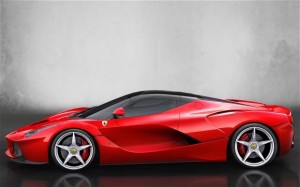Both, actually. Two news items from the Geneva Motor Show should make everyone stop and think about the future of vehicles and their impact on climate change.
- “LaFerrari”, the newest, fastest and most powerful vehicle from the iconic Italian automaker, is a hybrid.
- Volkswagen announced that it would begin selling the XL1, a two-seat hybrid that achieves 316 mpg.

Other than the “wow” factor, though, why should anyone care? After all, with production of only 499 vehicles for LaFerrari (not to mention its $1.5 million price) and 50 for the first year of the Volkswagen XL1, these vehicles would seem to have no impact on most of us. That conclusion would be wrong.
What these two vehicles have in common is much harder to see, but equally important. Both tell us a lot about where auto technology is going, what we’ll be driving and the impact our driving will have on greenhouse gas emissions and climate change.
Hybrid technology isn’t just for the environment
The fact that the manufacturer of the world’s fastest automobiles is incorporating hybrid technology to get the 950 horsepower it needed to produce the world’s most powerful car makes clear that electric motors and technology are not just ways to reduce emissions.
With almost any technology in the world to choose from when producing a $1.5 million vehicle, Ferrari chose hybrid. The electric motor added 116 horsepower to the 789 produced by Ferrari’s most powerful engine to deliver 950 horsepower total. By way of comparison, that electric motor delivers slightly more horsepower than the one powering the Volkswagen XL1.
Reducing weight improves performance and efficiency
Car makers are racing to reduce the weight of all their vehicles. Less weight means less power is needed to get the vehicle up to speed and keep it moving. That trend has been most apparent to consumers in the use of plastic body panels and bumpers. But both the Ferrari and the VW have body chassis made from carbon-fiber composites. That’s a clear indication that innovation and advanced technology will permeate the entire spectrum of vehicles.
A comparison of vehicle weights makes the potential impact clear. A Toyota Camry weighs about 2,800 pounds. The 1,750 pound weight of the VW XL1 shows one path to improvement. The Ferrari’s 2,800 pounds, when compared to the nearly 5,000 pounds of the Ford F150 pickup, shows another.
Greenhouse Gas Emissions
Fully electric vehicles like the Nissan Leaf put no carbon dioxide into the atmosphere when they drive. The 21 g/km CO2 emissions of the VW XL1 shows that it is possible to get near-zero tailpipe emissions for a wider-range of vehicles. A 4-cylinder Toyota Camry sedan produces 175 g/km, while the 6-cylinder Camry produces 250 g/km. If LaFerrari “only ” generates 330 g/km with a combination of a V12 engine and an electric motor, there is clearly room for innovation and improvement in mainstream autos.
That 330 g/km number for the Ferrari has another positive message. This is an unbelievably powerful vehicle. It delivers 660 lb ft of torque, a measure of engine power. That’s over six times as much as the VW (103 lb ft) and almost four times that of a Camry. But it’s also 75% more torque than a Ford 150 truck. Yet the Ferrari has slightly lower emissions than the the Cadillac V8 Escalade (339 g/km) and the Ford 150 light truck (340 g/km) currently on the road. Lower emissions are possible even for vehicles that need power.
Aerodynamics matter – a lot
A Ferrari screams speed and aerodynamics. Its distinctive look and image send that message even to someone who knows nothing about auto performance. By contrast, the VW XL1 looks something like the early Prius. But that shape results in a very low coefficient of drag, a measure of how much work the car must do to propel itself against the air. However it is achieved, the importance of shape to efficiency and performance is clear.
There’s much more to aerodynamic efficiency than shape, though. The Ferrari incorporates active aerodynamics, where constant computer monitoring of the car’s performance deploys diffusers and spoilers, aerodynamic devices that change the car’s aerodynamic profile. Those are in turn integrated with the other control systems to achieve optimal performance. Versions of those systems will appear in all vehicles over time.
The tip of the iceberg
The Odd Couple pairing of Ferrari and Volkswagen is just the tip of the iceberg of change in the automotive industry. Incorporating electric technology, reducing vehicle weight, reducing CO2 emissions and improving aerodynamics are major trends that are changing what we drive and the impact our driving will have on climate change and the environment.
